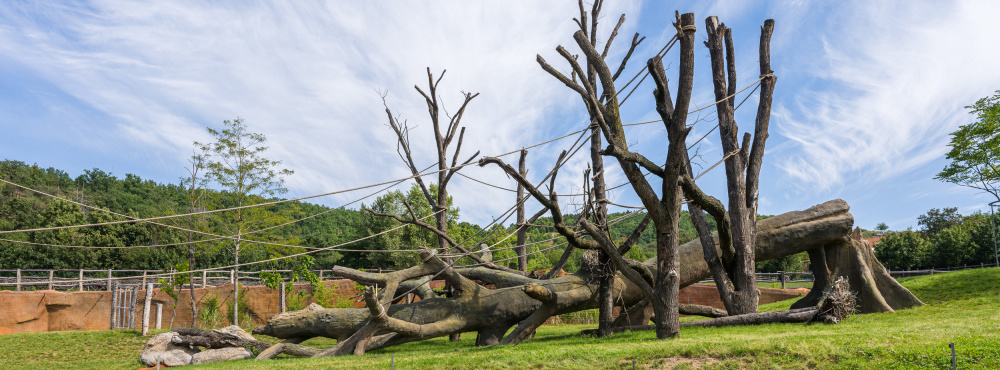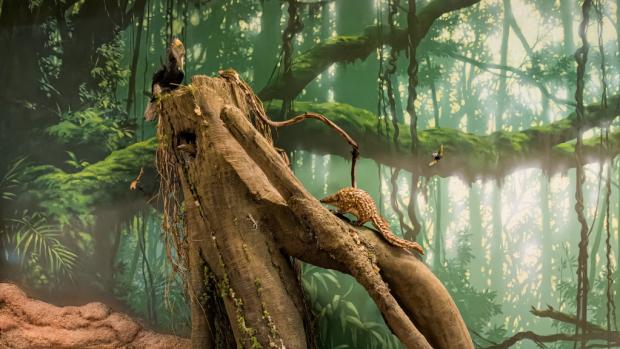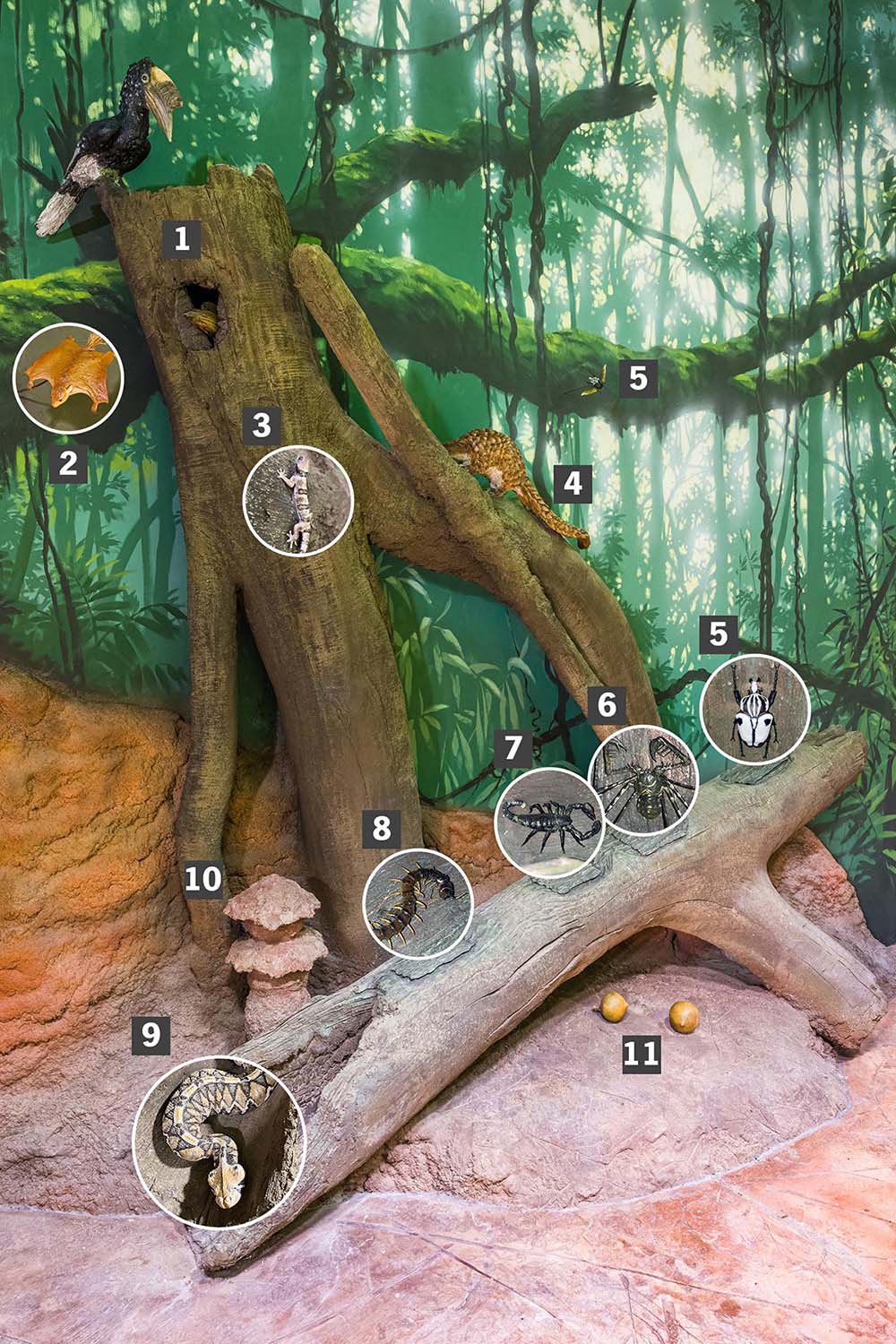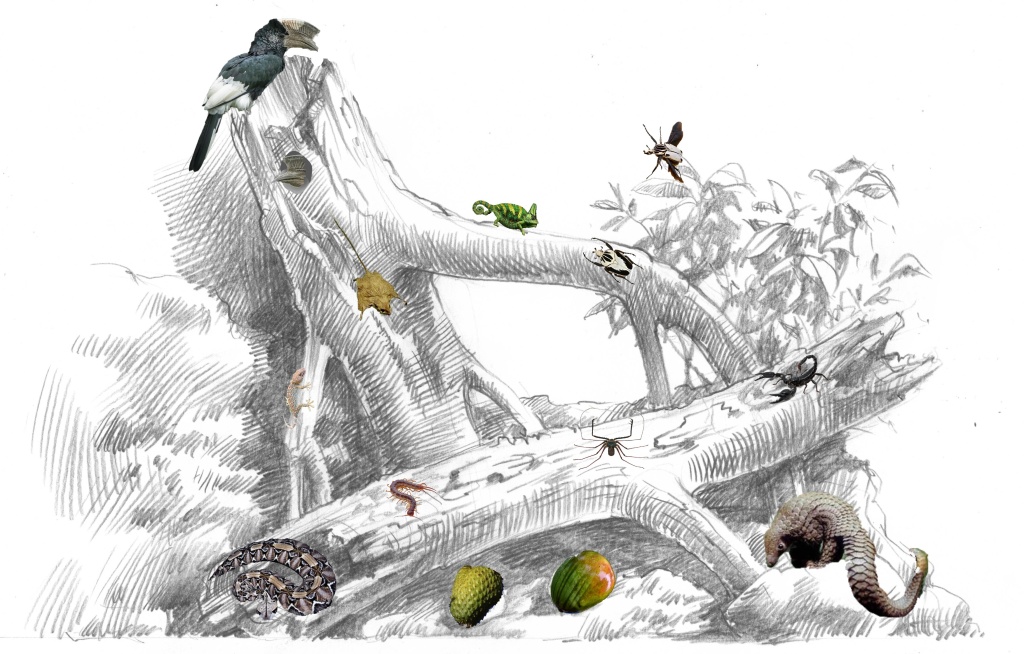The tree diorama

 The tree diorama, complete with a mural background. Some of the animals in the shotcrete trees can also be found hidden beneath hinged pieces of bark. Photo: Petr Hamerník, Prague Zoo
The tree diorama, complete with a mural background. Some of the animals in the shotcrete trees can also be found hidden beneath hinged pieces of bark. Photo: Petr Hamerník, Prague Zoo
One of the elements illustrating the tropical rainforest’s extraordinary biodiversity is the tree diorama. Made of shotcrete, it is “inhabited” by a rich mosaic of custom-made animal models. The display highlights the close relationship many rainforest species have with trees—both standing and fallen—which provide them with shelter, living space, and food.
The trees’ inhabitants

1. Hornbills nest in tree cavities up to 30 metres above the ground. The male brings lumps of mud, which both he and his partner use to wall up the entrance hole, leaving only a small slit through which the male passes food to the female—sealed inside throughout the whole incubation and brooding period. She only leaves the nest together with the chicks, approximately four months later. Black-and-white-casqued hornbills (Bycanistes subcylindricus) lay two eggs, though usually only the first-hatched chick is raised successfully, while the second starves.
2. Scaly-tailed squirrels are one of several groups of mammals that have independently evolved the ability to glide. These rodents take their name from the pointed scales on the underside of the tail. Pygmy scaly-tailed flying squirrel (Idiurus zenkeri) has been known to science since the end of the 19th century, yet we still know very little about it. During the day, it shelters in tree cavities that may be shared by up to forty
3. Tropical rainforests remain a largely unexplored realm. They hide a multitude of species that we previously knew nothing about, and many more await discovery. The gecko Hemidactylus coalescens was scientifically described in 2014, when what was once thought to be a single widespread gecko species turned out to consist of five distinct species. Its name refers to the coalescent method, used in phylogenetics, to delimit species.
4. The tree pangolin (Phataginus tricuspis), also known as the white-bellied pangolin, is one of three pangolin species found in Cameroon. Thanks to its prehensile tail, it is an adept climber and uses its powerful claws to tear open nests of ants and termites, on which it feeds. Pangolins are highly endangered—hunted for their prized meat and killed for their scales, which are trafficked in large quantities to Asia as a supposed remedy.
5. Goliath beetles (Goliathus goliatus) are among the largest insects in the world. They can reach up to 11 cm in length and weigh as much as 100 grams. Despite their substantial weight, they are capable of flight. When flying, they keep their elytra closed and extend the membranous wings beneath them, as is typical of all flower chafers, to which goliath beetles belong. Adults feed on sugary foods, such as plant sap and fruits.
6. Whip scorpions are ancient arachnids that have been on Earth for more than 300 million years. They inhabit tropical regions worldwide and, unlike true scorpions, are not venomous. They catch insects using specially adapted pedipalps. The first pair of legs, which are long and slender, are not used for walking but serve as sensory organs. They often scuttle sideways like crabs. Some species (e.g. those of the genus Damon) have even been observed exhibiting social behaviour.
7. Despite their size, emperor scorpions are only mildly venomous. They hunt mainly with their powerful pedipalps, which have evolved into pincers. The African emperor scorpion (Pandinus dictator), also known as the dictator scorpion, is widespread in Cameroon, Congo, Gabon and Equatorial Guinea.
8. The centipede Alipes multicostis has its last pair of legs modified into leaf-like flags, which it waves from side to side when disturbed, producing a rustling sound. When under attack by a predator, it can also shed these flags, thereby distracting its assailant. The detached flag can continue to rustle for up to thirty seconds.
9. The Gaboon viper (Bitis gabonica) is perfectly camouflaged among the forest leaf litter, where it lies in wait for passing prey. It has the longest fangs of any venomous snake (up to 5 cm), which it sinks into its prey to deliver venom. It feeds on small mammals and birds but can even take small antelopes.
10. The rainforest is home to many species of termite that construct remarkable nests using a mixture of soil, saliva and organic material. Cubitermes termites build spongy-shaped mounds. Thanks to small eaves, water cannot seep inside. The nests of a related genus, Procubitermes, are found on the trunks of large trees, where they form multi-storey, jagged overhangs.
11. Tree fruits provide a welcome food source for many rainforest animals. The fruits of the moabi tree (Baillonella toxisperma), for example, are eaten by forest elephants, which also help disperse its seeds.
How the models were created

The first sketch of the tree diorama was prepared by artists Roman Hudziec and Kryštof Krejča based on a species list from the Cameroonian Dja Reserve. Sketch: Roman Hudziec, Kryštof Krejča
The animal models were created by sculptor Miroslav Jakubčík. Larger animals were originally sculpted from clay or modelling plastiline, and moulds were then made from these to produce polyurethane casts. In the case of invertebrates, however, it would be impossible to model such fine structures as insect limbs by hand. These models were therefore printed on a special 3D printer using laser-cured epoxy resin, based on detailed digital scans, making them faithful replicas of the originals.
Some models—such as the Gaboon viper—were made using a combination of both techniques. The head was 3D-printed, while the body was sculpted separately, directly into a cavity "live" in the Feline and Reptile House, using a living specimen for reference. After surface finishing and touch-ups, the models were painted using automotive paints.
ZOOPRAHA.CZ
Contacts
- The Prague zoological garden
U Trojskeho zamku 120/3
171 00 Praha 7
Phone.: (+420) 296 112 230 (public relations department)
e-mail: zoopraha@zoopraha.cz
Others










